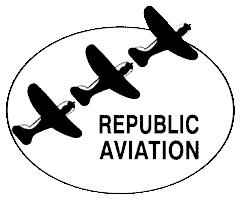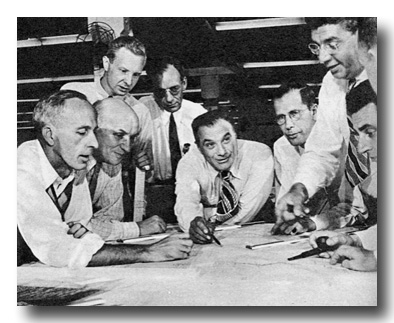 Republic Aviation
Corporation was established in 1939 when the board of directors of Seversky
Aircraft ousted Alexander de Seversky as company president because of
mounting losses and changed the company's name to Republic. W. Wallace
Kellett became the new company president.
Republic Aviation
Corporation was established in 1939 when the board of directors of Seversky
Aircraft ousted Alexander de Seversky as company president because of
mounting losses and changed the company's name to Republic. W. Wallace
Kellett became the new company president.
One of the
last planes produced by Seversky aircraft had been the AP-4, an
adaptation of the P-35, the first modern fighter. The AP-4 was equipped
with a Pratt & Whitney R-1830 radial engine enhanced by a
supercharger. In March 1939, the Army ordered 13 of these AP-4 test
models, designated YP-43. They were delivered in September 1940 as
Republic P-43 Lancers. By 1941, new air combat technology had overtaken
the Lancer's technology, and Republic's chief designer, Russian émigré
Alexander Kartveli, began planning what would turn into the P-47
Thunderbolt. But since the engine that would power the P-47, Pratt &
Whitney R-2800 Double Wasp, was not yet available, the U.S. Army Air
Corps (USAAC) ordered some almost 2,000 P-43 Lancers to be used in the
meantime. Another 108 went to the Chinese Air Force through the
Lend-Lease program. None of the U.S. P-43s saw combat duty but served in
a training, and later in a photoreconnaissance, role.
 The P-47
Thunderbolt that was on Kartveli's drawing board in 1940 is ranked as
one of the three best fighters of World War II along with Lockheed's
P-38 Lightning and North American's P-51 Mustang. The P-47 sported a
massive fuselage, used the Pratt & Whitney R-2800 Double Wasp engine
enhanced with a turbocharger, and was the heaviest single-engine fighter
to fly in the war. The USAAC ordered the 171 prototype XP-47B in
September 1940, and 773 planes more soon after. The plane was designed
around the turbocharger from the start, which was situated in the rear
fuselage to keep the plane balanced, and was connected to the engine by
a long piece of ducting. It also had an unusual telescopic landing gear
that allowed room for all the guns.
The P-47
Thunderbolt that was on Kartveli's drawing board in 1940 is ranked as
one of the three best fighters of World War II along with Lockheed's
P-38 Lightning and North American's P-51 Mustang. The P-47 sported a
massive fuselage, used the Pratt & Whitney R-2800 Double Wasp engine
enhanced with a turbocharger, and was the heaviest single-engine fighter
to fly in the war. The USAAC ordered the 171 prototype XP-47B in
September 1940, and 773 planes more soon after. The plane was designed
around the turbocharger from the start, which was situated in the rear
fuselage to keep the plane balanced, and was connected to the engine by
a long piece of ducting. It also had an unusual telescopic landing gear
that allowed room for all the guns.
The plane
entered production in early 1942, and early in 1943 began service with
Britain's Royal Air Force as escorts to the B-17 and B-24 bombers. The
P-47s could also carry bombs, which turned the fighters into
fighter-bombers with the P-47D "Juggernaut," the first
large-scale production model. The Juggernaut version carried out
strafing and bombing missions with deadly effect in the European and the
Pacific theaters until the end of the war. The U.S. Army Air Forces (USAAF)
ordered 850 in October 1941. (The Army Air Corps had been reorganized as
the Army Air Forces.) Republic produced 12,602 P-47Ds, the largest
number of a single sub-type of any fighter in history. Total P-47D
production was 15,660.
Production
of the P-47 ended in November 1945. The company tried two other aircraft
with little success. The Seabee amphibian incurred large losses after
good initial sales. The F-12 reconnaissance aircraft was the fastest
multiengine piston-powered aircraft ever flown. It was cancelled,
however, and Republic transformed the design into the commercial 40-seat
RC-2 Rainbow ordered by American and Pan Am airlines. It, too, was cancelled,
and the company was left in precarious financial position.
The new
postwar P-84/F-84 jet fighter-bomber returned Republic to profitability.
The company built three main varieties of this plane to replace the
P-47. The first, the P-84 Thunderjet (changed to F-84 on June 11, 1948),
first flew on February 28, 1946. It was the last of Republic's
straight-wing jet designs. The Thunderjet was a high-performance
aircraft, and briefly set an American speed record, flying at 611 miles
per hour (983 kilometers per hour) in September 1946. It kept the record
for one day, when a Gloster Meteor flying at 616 miles per hour (991
kilometers per hour) set a new record. The last in the Thunderjet
series, the F-84G, could deploy nuclear weapons and was the first
fighter capable of in-flight refueling. Used by American forces in
Korea, by NATO troops, and by some nonaligned nations, approximately
4,450 Thunderjets were built between 1947 and 1953.
The second
F-84 was the swept-wing F-84F Thunderstreak. After several manufacturing
delays and a switch to a more powerful engine, the first production
F-84F flew in the fall of 1952. About 2,700 were built, with 1,300 going
to NATO forces. The F-84F served with the Tactical Air Command (TAC) and
with the Strategic Air Command (SAC). Those with the TAC were equipped
to deliver nuclear weapons using the Low Altitude Bombing System (LABS).
The strategy was for the F-84F to race toward the target at treetop
level. When near the target, the F-84F would make a half loop upward,
release its bomb, and then escape the nuclear blast with a rapid
high-speed maneuver and head back from where it came. Fortunately, the
Thunderstreak never had to carry out this mission in real combat.
The RF-84F
Thunderflash was the final F-84. It was the first of the modern jets to
be designed specifically for photoreconnaissance and the first
fighter-type plane to carry cameras that could take horizon-to-horizon
pictures. Republic produced 715 of the aircraft. First flown in 1953 and
used for many years, the plane was eventually withdrawn from service in
1971.
At the same
time that Republic was working on the F-84, Kartveli and his team were
designing Republic's first swept-wing plane, a high-speed experimental
interceptor designated the XF-91 Thunderceptor. Begun in 1946, it was
America's first combat-type fighter to fly faster than the speed of
sound. The plane used a variable-incidence wing that could be adjusted
in flight for the most effective angle during takeoff, cruise, and
landing. The plane first flew at Edwards Air Force Base on May 9, 1949.
In December 1951, it became the first U.S. combat aircraft to go
supersonic in level flight. The Thunderceptor never went into production
because it could not carry fuel for flights lasting longer than 25
minutes and did not have the latest type of fire control system but it
led to further developments in advanced fighter technology.
In 1951,
Republic began to develop a supersonic fighter-bomber to replace the
F-84F. The F-105 Thunderchief, also nicknamed "Thud" (some say
with affection and others say because the plane was too heavy), made its
first flight on October 22, 1955, although the first production version,
the F-105B, was not delivered until May 1958. This supersonic aircraft
had an internal bomb bay, the first ever on a fighter aircraft, and was
capable of deploying nuclear weapons. It was the heaviest and most
complex fighter used by the Air Force to date. The F-105 exhibited the
pinched-waist fuselage to conform to the new "area rule"
concept for reduced aerodynamic drag at transonic speeds.
The F-105D
first flew in 1959 and was the main production version with more than
600 built. It was used extensively in Vietnam, flying 75 percent of the
air strikes against North Vietnam during the first four years of the war
and participating in "Operation Rolling Thunder," which began
in March 1965. Featuring highly sophisticated electronics, its
navigation system automatically supplied the pilot with current position
coordinates, ground speed, distance to target, and other information.
The F-105D was considered the first "black box" fighter and
was the only aircraft that could penetrate the Soviet-provided air
defense system protecting North Vietnam.
The final
production version was the F-105F, of which 86 were converted for
"Wild Weasel" missions against North Vietnam beginning in
1967. Sixty F-105Fs were redesignated as F-105G and outfitted with
greatly improved avionics. The sophisticated electronics on these planes
were used to counter hostile radar-controlled surface-to-air weapons by
jamming the enemy's radar.
Thunderchiefs
flew more than 20,000 combat missions in Vietnam. More than half of the
planes built were lost in combat, not considered a bad record when
considering the number of missions flown. The F-105 was Republic's last
independent design.
Republic
attempted to diversify, establishing a helicopter division in December
1957 and building the French Alouette helicopter under license. It also
introduced a turboprop airliner—the Rainbow—for short to
medium-distance routes, but interest was light and the project ended.
Republic acquired a minority interest in the Dutch aircraft firm Fokker
and attempted to market an attack plane in 1960. None of these efforts
was successful.
Meanwhile,
after acquiring Republic stock, the aerospace company Fairchild acquired
Republic in July 1965. In September, Republic became the Republic
Aviation Division of Fairchild Hiller, ending Republic's existence as an
independent company.
Judy
Rumerman
This
excellent article was written by Judy Rumerman.
Here
is the orginal article!